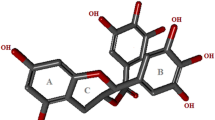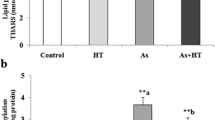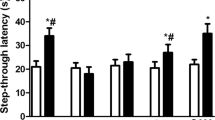Abstract
Gallic acid is known as a potent antioxidant active compound of the edible and medicinal plant Peltiphyllum peltatum. The main objective of this study was to evaluate the neuroprotective effects of gallic acid against sodium fluoride induced oxidative stress in rat brain. Gallic acid (10 and 20 mg/kg) and vitamin C (10 mg/kg) were intraperitoneally administrated for 1 week prior to sodium fluoride intoxication. After the treatment period, brain tissues were collected and homogenized, and antioxidant parameters were measured in the homogenates. The level of thiobarbituric acid reactive substances in sodium fluoride intoxicated rats (42.04 ± 2.14 nmol MDA eq/g tissue, p < 0.01 vs. normal) increased compared to the normal rats (35.99 ± 1.08 nmol MDA eq/g tissue). Pretreatment with gallic acid at 20 mg/kg was exhibited significant reduction in the thiobarbituric acid reactive substances level (37.06 ± 1.4 nmol MDA eq/g tissue, p > 0.05 vs. normal). This increasing in thiobarbituric acid reactive substances level was accompanied with a decrease in the level of reduced glutathione (6.74 ± 0.28 μg/mg of protein, p < 0.001 vs. normal), superoxide dismutase (53.24 ± 1.62 U/mg of protein, p < 0.001 vs. normal) and catalase (70.73 ± 2.94 μmol/min/mg of protein p < 0.001 vs. normal) activities in sodium fluoride intoxicated rat. Gallic acid at 20 mg/kg was significantly modified the level of reduced glutathione (11.02 ± 0.53 μg/mg of protein, p < 0.05 vs normal) and catalase activity (89.22 ± 3.67 μmol/min/mg of protein, p > 0.05 vs. normal) in rat brain. However, gallic acid at 20 mg/kg was significantly more effective in retrieving superoxide dismutase (124.78 ± 5.7 U/mg of protein) activity than vitamin C (115.5 ± 4.97 U/mg of protein).
Similar content being viewed by others
Explore related subjects
Discover the latest articles, news and stories from top researchers in related subjects.Avoid common mistakes on your manuscript.
Fluoride anions are essential elements in living organisms. Fluoride can ameliorate dental caries and enamel fluorosis (He and Chen 2006). Dental caries result in the demineralization of hard tissues (such as enamel, cementum and dentin) and/or decomposition of organic compounds in tooth caused by the acids that has been generated by bacteria via hydrolysis of food debris. Enamel fluorosis is an important disease in different areas of the world such as India, China, and Mexico where the water sources contain an excess of fluoride (Pendrys 2001). In addition to dental diseases, neurological disorders (reduced intelligence quotient levels in children, cognition and memory impairment and reduced learning ability) have also been reported in fluoride polluted areas (Madhusudhan et al. 2009). We previously reported a correlation between fluoride consumption and oxidative stress in the brain of experimental animals. In brain, fluoride passes the blood brain barrier and induces neural cells degeneration (Nabavi et al. 2011). We also observed that fluoride toxicity increased lipid peroxidation in brain tissues which may explain the mechanism of action of this toxicity (Nabavi et al. 2012a). Others have also shown that fluoride intoxication leads to irregular changes in cellular mechanisms of brain cells (Bharti and Srivastava 2009).
It is well known that reactive oxygen species (ROS) play a crucial role in fluoride-induced oxidative stress in neural tissues (Eraslan et al. 2007). Recent studies have determined the mitigative action of natural compounds as antioxidant agents in ROS-induced neurological disorders (Nabavi et al. 2011). Gallic acid (3, 4, 5-trihydroxybenzoic acid, Fig. 1) is one of the most important polyphenolic compounds in plants (Eslami et al. 2010) and is considered a putative active compound in tannin. Gallic acid and its derivatives are considered the main polyphenolic compounds in blackberry, raspberry, mango, areca nut, bearberry and walnut (Tachibana et al. 2004). Several biological activities of gallic acid such as antiviral, antifungal, anticancer and antioxidant have been previously reported (Li et al. 2005). Gallic acid has also been used in food, cosmetics, and in pharmaceuticals as an antioxidant (Zhao et al. 2011).
To the best of our knowledge, there is no published scientific report on the preventive role of gallic acid against sodium fluoride induced oxidative stress in rat brain. In this work, we evaluated the protective effects of gallic acid isolated from Peltiphyllum peltatum in fluoride induced oxidative stress and determined whether this preventive effect is modulated via antioxidant mechanisms in the brain.
Materials and Methods
Bovine serum albumin and the kit for protein measurement were purchased from ZiestChem Company (Tehran, Iran). 5,5-dithiobis(2-nitrobenzoic acid), glacial acetic acid, heparin, nitro blue tetrazolium chloride, potassium dihydrogen phosphate, reduced glutathione (GSH), sodium dihydrogen phosphate, sodium fluoride, trichloroacetic acid, thiobarbituric acid, hydrogen peroxide were purchased from Sigma-Aldrich chemical company (St Louis, MO, USA). Other chemical reagents were of analytical grade or better. P. peltatum is grown and maintained in our medicinal gardens and has been used as a source of gallic acid. The isolation and identification of gallic acid from this plant has been described previously (Habtemariam 2008).
Fifty Male Wistar rats (200–250 g) used for present study were purchased from Pasteur Institute of Iran, Amol, Mazandaran, Iran and housed at the animal room of the University of Mazandaran (Babolsar, Iran) and kept in plastic cages (47 × 34 × 18 cm3) with saw dust (renewed after every 24 h), under controlled temperature of 20–25°C and 12/12 h light/dark cycle. Animals were fed with standard pellet rat diet. Animals were allowed 2 weeks to acclimatize prior starting the experiments. Experiments were performed after the approval of the University of Mazandaran Institutional Animal Care and Use Committee (Approval number: No.S-2009 UMZ).
Animals were divided into five different groups (n = 10). The first group was considered as the control group and only received serum saline (0.9 % NaCl i.p.). The second group (NaF group) was treated with saline plus sodium fluoride through drinking water (600 ppm, 1 week). The third and fourth groups received gallic acid at 10 and 20 mg/kg i.p., respectively, for 1 week prior to the consumption of sodium fluoride at 600 ppm through drinking water. The fifth group was treated with vitamin C at 10 mg/kg i.p., during the pretreatment week and then consumed sodium fluoride at 600 ppm through drinking water. Experimental procedure schedule are presented in Fig. 2. Animals were anesthetized with ketamine (60 mg/kg i.p.) and xylazine (5 mg/kg i.p.) and sacrificed 24 h after last treatment and the brain of the animals was removed.
The entire brain was homogenized in potassium dihydrogen phosphate buffer containing ethylenediaminetetraacetic acid and then centrifuged at 16,000 g for 30 min at 4°C. The upper layer was recovered and used for biochemical analysis.
The protein concentration of the homogenates of the five groups was evaluated according to the method described by Bradford (1976).
Lipid peroxidation was examined in terms of thiobarbituric acid reactive substances (TBARS) (Ozturk et al. 2010) levels. Tissue homogenates (containing 1 mg protein) were precipitated with 20 % of trichloroacetic acid (0.5 mL). After centrifugation at 6,000 g for 10 min at 4°C, 0.67 % of acid (1 mL) was added to the supernatants of the reaction mixture (0.9 mL) and then heated in boiling water (10 min). Finally, the absorbance of reaction mixture was recorded at 532 nm.
Superoxide dismutase activity was evaluated by the method of Misra and Fridovich (1972). The reaction mixtures contained 1 mL of sodium carbonate (50 mM), 0.4 mL of nitroblue tetrazolium (25 μm) and 0.2 mL of freshly prepared hydroxylamine hydrochloride (0.1 mM). 0.1 mL of clear supernatant of tissue homogenates (1:10 w/v) were added to the reaction. The reaction was monitored at 560 nm.
Catalase activity was measured by a spectrophotometric method based on the decomposition of hydrogen peroxide (H2O2) (Pari and Latha 2004). The brain homogenates were centrifuged at 6,000g for 30 min at 4°C and the reaction was started through the addition of H2O2 (30 %). The catalase activity was recorded at 240 nm. The levels of GSH were evaluated by the method of Ellman (1959). Adequate dilutions of homogenates were deproteinized with trichloroacetic acid (5 % in methanol). After 5 min of centrifugation at 10,000 g at 4°C, the upper layer was recovered and 5, 5-dithiobis (2-nitrobenzoic acid solution (Ellman’s reagent) was added to the reaction. The absorbance of the reaction mixture was recorded at 417 nm.
The values are presented as means ± SD. Differences between group means were estimated using one-way analysis of the variance followed by Duncan’s multiple range tests. Results were considered statistically significant when p < 0.05.
Results and Discussion
Thiobarbituric acid reactive substances (TBARS) levels in brain homogenates are reported in Fig. 3. Fluoride intoxication induced a significant increase in TBARS levels when compared with the control group (p < 0.01). Gallic acid in a dose dependent manner and vitamin C administration decreased the TBARS levels in rat brains exposed to sodium fluoride (p < 0.05). Superoxide dismutase activity significantly decreased in the brain after fluoride intoxication and this reduction was mitigated by gallic acid (20 mg/kg) and vitamin C administration (Fig. 4). Gallic acid at 20 mg/kg was significantly more effective in retrieving superoxide dismutase (SOD) activity than vitamin C (p < 0.05). Treatment of rats with sodium fluoride resulted in a significant decrease in catalase activity (p < 0.001) (Fig. 5). Gallic acid in a dose dependent manner and vitamin C treatment significantly reduced the loss in catalase activity after sodium fluoride treatment (p > 0.05). Fluoride intoxication induced a significant reduction in GSH levels when compared to the control group (p < 0.001). Pretreatment with gallic acid attenuated the GSH reduction in a dose dependent manner (Fig. 6).
Reactive oxygen species (ROS) play a direct role in pathogenesis of different disease conditions including inflammation, burn and neurodegenerative diseases (Madhusudhan et al. 2009). It is well known that fluoride accumulation in tissues leads to oxidative stress condition through increasing ROS production and suppressing endogenous antioxidant enzyme system (Ranjan et al. 2009). Liu et al. (2003) reported that fluoride toxicity disturbs the cellular function and structure by stimulating an excessive nitric oxide production, which may lead to oxidative stress.
We have previously shown that plant derived natural products can offer protection against sodium fluoride induced oxidative stress (Nabavi et al. 2011) and that the antioxidant properties of these compounds may explain their protective activity (Nabavi et al. 2012a, b). Gallic acid is a well known natural compound with potent antioxidant and free radical scavenging abilities (Lu et al. 2006). Its metabolites are the products of decarboxylation, methylation and dehydroxylation processes. In nature, these metabolites are found in two forms, methylated gallic acids form or galloyl conjugates of catechin. In addition to their antioxidant effects, there are numerous reports on their other biological activities such as its anti-cancer and anti-apoptotic potentials (Dwibedy et al. 1999; Sohi et al. 2003).
In the present study, we showed that gallic acid ameliorated sodium fluoride induced oxidative state in the rat brain. Neuroprotective activities of gallic acid against 6-hydrodopamine auto-oxidation induced apoptosis in human SH-SY5Y cells (Lu et al. 2006) and amyloid beta protein (25–35) induced toxicity in cultured rat cortical neurons (Ban et al. 2008) have been previously reported. In this study, protective effects of gallic acid treatment against sodium fluoride-induced oxidative stress in rat brain were studied. It has been reported that the antioxidant consumption ameliorates sodium fluoride induced neurotoxicity through scavenging free radicals and suppressing ROS generation (Nabavi et al. 2011). Antioxidant activity of gallic acid is dependent on the phenolic hydroxyl groups of the molecule (Lu et al. 2006).
Antioxidant enzyme activities, TBARS and GSH levels were normalized with increasing gallic acid doses. Decrease in lipid peroxidation level caused by gallic acid was parallel to other studies that reported reductions in lipid peroxidation in pancreatic tissue of rat intoxicated with streptozotocin (Punithavathi et al. 2011) or decreased malondialdehyde levels of the liver, brain and kidney of the aged mice (Li et al. 2005). Kim (2007) reported that treatment with gallic acid lead to an increase in GSH levels and a reduction in oxidized glutathione (GSSG). It is well known that the GSH/GSSG ratio enhancement by gallic acid is enhanced with the addition of the hydroxyl groups (Kim 2007). The presence of a hydroxyl group at para-position to COOH group may be responsible for the antioxidant activity of gallic acid derivatives and may explain the protective mechanism against sodium fluoride induced oxidative stress.
In summary, sodium fluoride caused neurotoxicity through alterations in oxidant/antioxidant homeostasis. Gallic acid consumption restored this harmful effect via its antioxidant action. Therefore, it can be concluded that this botanical compound may be a potent antioxidant agent that can mitigate the neurotoxicity of fluoride by inhibiting the initiation and/or propagation of the lipid peroxidation. Future studies are needed to fully characterize the mechanisms of neuroprotective action.
References
Ban JY, Nguyen HT, Lee HJ, Cho SO, Ju HS, Kim JY, Bae K, Song KS, Seong YH (2008) Neuroprotective properties of gallic acid from Sanguisorbae radix on amyloid beta protein (25–35)-induced toxicity in cultured rat cortical neurons. Biol Pharm Bull 31(1):149–153
Bharti VK, Srivastava RS (2009) Fluoride-induced oxidative stress in rat’s brain and its amelioration by buffalo (Bubalus bubalis) pineal proteins and melatonin. Biol Trace Elem Res 130:131–140
Bradford MM (1976) A rapid and sensitive method for the quantitation of microgram quantities of protein utilizing the principle of protein-dye binding. Anal Biochem 72:248–254
Dwibedy P, Dey GR, Naik DB, Kishore K, Moorthy PN (1999) Pulse radiolysis studies on redox reaction of gallic acid: one electron oxidation of gallic acid by hallic acid OH adduct. Phys Chem Chem Phys 1:1915–1918
Ellman GL (1959) Tissue sulphydryl group. Arch Biochem Biophys 82:70–77
Eraslan G, Kanbur M, Silici S (2007) Evaluation of propolis effects on some biochemical parameters in rats treated with sodium fluoride. Pest Biochem Physiol 88:273–283
Eslami AC, Pasanphan W, Wagner BA, Buettner GR (2010) Free radicals produced by the oxidation of gallic acid: an electron paramagnetic resonance study. Chem Cent J 4:15
Habtemariam S (2008) Activity-guided isolation and identification of antioxidant components from ethanolic extract of Peltiphyllum peltatum (Torr.) Engl. Nat Prod Commun 3:1321–1324
He LF, Chen JG (2006) DNA damage, apoptosis and cell cycle changes induced by fluoride in rat oral mucosal cells and hepatocytes. World J Gastroenterol 12(7):1144–1148
Kim YJ (2007) Antimelanogenic and antioxidant properties of gallic acid. Biol Pharm Bull 30(6):1052–1055
Li L, Ng TB, Gao W, Li W, Fu M, Niu SM et al (2005) Antioxidant activity of gallic acid from rose flowers in senescence accelerated mice. Life Sci 77:230–240
Liu GY, Chai CY, Li C (2003) Fluoride causing abnormally elevated serum nitric oxide levels in chicks. Environ Toxicol Pharmacol 13:199–204
Lu Z, Nie G, Belton PS, Tang H, Zhao B (2006) Structure–activity relationship analysis of antioxidant ability and neuroprotective effect of gallic acid derivatives. Neurochem Int 48:263–274
Madhusudhan N, Basha PM, Begum S, Ahmed F (2009) Fluoride-induced neuronal oxidative stress and its amelioration by antioxidants in developing rats. Fluoride 42(3):179–187
Misra HP, Fridovich I (1972) The role of superoxide anion in the autooxidation of epinephrine and simple assay for superoxide dismutase. J Biol Chem 247:3170–3175
Nabavi SF, Eslami Sh, Moghaddam AH, Nabavi SM (2011) Protective effects of curcumin against fluoride-induced oxidative stress in the rat brain. Neurophysiology 43(4):287–291
Nabavi SF, Nabavi SM, Abolhasani F, Moghaddam AH, Eslami S (2012a) Cytoprotective effects of curcumin on sodium fluoride-induced intoxication in rat erythrocytes. Bull Environ Cont Toxicol 88:486–490
Nabavi SM, Nabavi SF, Eslami S, Moghaddam AH (2012b) In vivo protective effects of quercetin against sodium fluoride-induced oxidative stress in the hepatic tissue. Food Chem 132:931–935
Ozturk OH, Oktar S, Aydin M, Kucukatay V (2010) Effect of sulfite on antioxidant enzymes and lipid peroxidation in normal and sulfite oxidase-deficient rat erythrocytes. J Physiol Biochem 66(3):205–212
Pari L, Latha M (2004) Protective role of Scoparia dulcis plant extract on brain antioxidant status and lipid peroxidation in STZ diabetic male Wistar rats. BMC Compliment Altern Med 4:4–16
Pendrys DG (2001) Fluoride ingestion and oral health. Nutrition 17:979–980
Punithavathi VR, Prince PSM, Kumar R, Selvakumari J (2011) Antihyperglycaemic, antilipid peroxidative and antioxidant effects of gallic acid on streptozotocin induced diabetic Wistar rats. Eur J Pharmacol 650:465–471
Ranjan R, Swarup D, Patra RC (2009) Oxidative stress indices in erythrocytes, liver, and kidneys of fluoride-exposed rabbits. Fluoride 42(2):88–93
Sohi KK, Mittal N, Hundal MK, Khanduja KL (2003) Gallic acid, an antioxidant, exhibits antiapoptotic potential in normal human lymphocytes: a Bcl-2 independent mechanism. J Nutr Sci Vitaminol 49:221–227
Tachibana H, Koga K, Fujimura Y, Yamada K (2004) A receptor for green tea polyphenol EGCG. Nat Struct Mol Biol 11:380–381
Zhao J, Khan IA, Fronczek FR (2011) Gallic acid. Acta Crystallogr Sect E Struct Rep 67(Pt 2):o316–o317
Acknowledgments
The authors acknowledge the financial support of National elite’s foundation of Iran (Tehran, Iran) for this study. This paper is dedicated to Seyed Maryam Nabavi, Seyed Morteza Nabavi and with memory of Seyed Ali Asghar Nabavi.
Author information
Authors and Affiliations
Corresponding author
Rights and permissions
About this article
Cite this article
Nabavi, S.F., Habtemariam, S., Jafari, M. et al. Protective Role of Gallic Acid on Sodium Fluoride Induced Oxidative Stress in Rat Brain. Bull Environ Contam Toxicol 89, 73–77 (2012). https://doi.org/10.1007/s00128-012-0645-4
Received:
Accepted:
Published:
Issue Date:
DOI: https://doi.org/10.1007/s00128-012-0645-4










